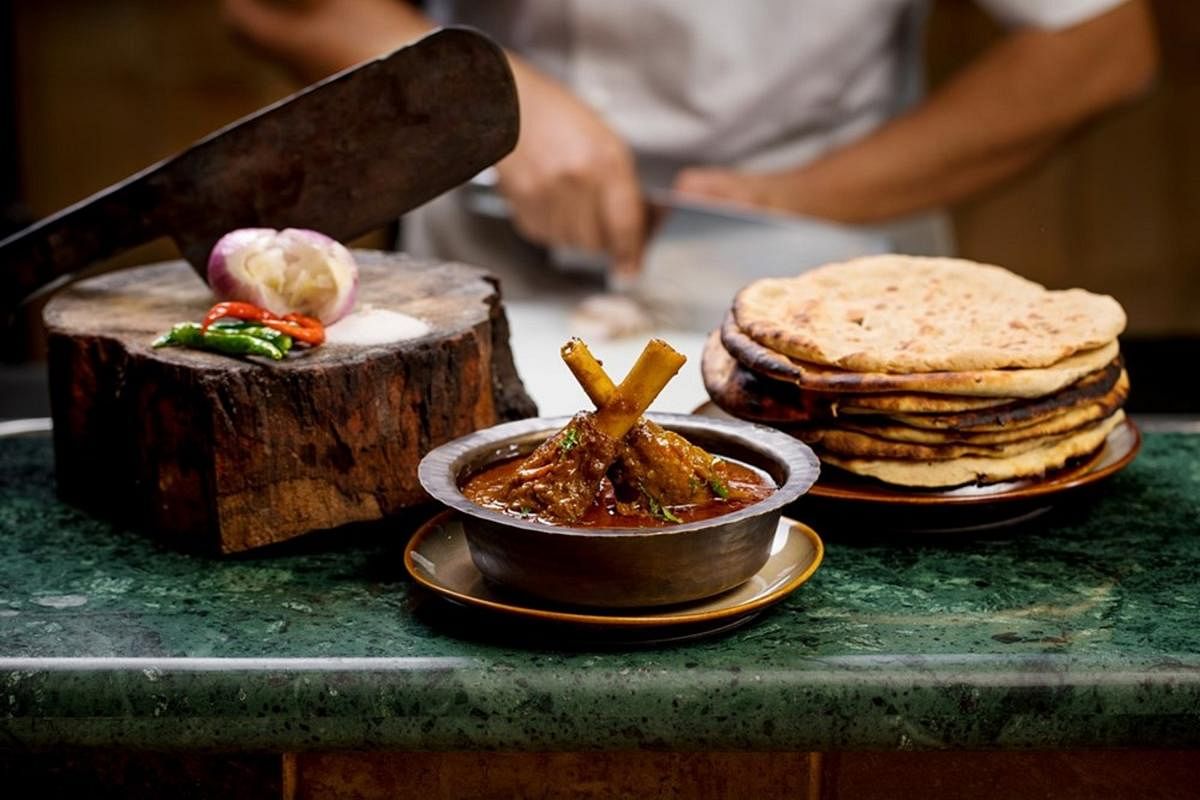It was close to 4 pm when I stepped out of the Bala Hisar gate of the majestic Golconda Fort, which was once the bastion of power for the Mughal kingdom of Mohammad Quli Qutub Shah in Hyderabad. As I walked towards my hotel located nearby, I chanced upon a middle-aged woman using a long hooked metal prong to take out soft, paper-thin, oval-shaped (about 20 inches long and 10 inches wide) flatbreads from the hot interiors of a traditional charcoal-fired cylindrical clay oven.
Lavash
Curious, I learnt that these paper-thin, oval-shaped flatbreads are called lavash, which are made of wheat. Roasted diced chicken or barbecued kebabs, wrapped in freshly baked beautifully blistered lavash, are popular tea-time snacks.
Interestingly, even in recent times, the technique of baking lavash remains the same as those worked out by bread bakers during the time of the Mughals in the 16th century. The soft, thin wheat flatbread is baked in a cylindrical clay oven.
The sheer variety of flatbreads in India is astounding. From naans to appams and from deep-fried bhathuras to Malabar parottas, the flatbreads are indicative of the country’s geography and are a clear representation of the region they belong to.
Sheermal
One of the most significant contributions made by the Mughals to Indian cuisine is in the form of flatbreads. During my travels, I came across yet another fascinating Mughal bread — the slightly sweet, soft, saffron and cardamom-laced sheermal. Around 4 inches to 5 inches in diameter, sheermals are ‘sheer’ indulgence. After some research, I learnt that the golden sheermal was an essential part of Awadhi and Hyderabadi cuisines and is savoured with lip-smacking shami kebabs or a rich nihari. Now, isn’t that a truly royal meal! The surface of the mildly sweetened wheat flour dough is brushed with a warm saffron-milk solution and then, baked in a tandoor to a golden brown colour.
A variety of distinctively flavoured Indian breads come with a rich history, stretching back to several thousand years, and are the ‘most-sought-after’ food staples today. Moreover, to prepare these breads, the emphasis is on adhering to the age-old techniques like baking in clay ovens, tandoors, steaming, grilling or even deep-frying on a tawa (cast iron griddle pan).
Kai pathiri
Let’s take, a clay pot-cooked flatbread like the kai pathiri for instance. According to historical records, this super thin white flatbread was popular with Arab merchants who settled in the Malabar region of Kerala, in the 7th century. At an eatery at Travancore, I was fascinated by the way in which these delicate white paper-thin discs are made. The pathiri (made of rice flour, grated coconut, onion and fennel seeds) is flattened and pressed between the palms (kai), placed in the heated chatty (traditional clay pot) and cooked on both sides until the pathiri is soft and puffy. A kai pathiri is served with the Malabar chicken curry.
Baati & litti
In the arid desert land of Rajasthan, a crumbly dough ball called baati, made of wheat flour, milk and ghee is an integral part of a meal. Dating back to 8th century, when Bappa Rawal was ruling at Mewar, baatis dunked in a bowl of dahi were considered a nutritious start to a day. Interestingly enough, in the recent times too, baatis are cooked over hot charcoal; then, served with the traditional sweet churma and the fragrant mildly spiced panchmel dal.
Then, we have the litti, which is filled with a mixture of roasted chickpeas flour or sattu, carom seeds, coriander and ghee. Traditionally, served with chokha, it is a complete meal in itself in regions of Bihar, Jharkhand and eastern Uttar Pradesh.
Khameeri
Old Delhi is filled with culinary delights and is the birthplace of many popular dishes that have become synonymous with Indian cuisine. Here, you will come across popular sourdough breads like the khameeri roti. Historically, the soft, light-textured khameeri rotis were used to scoop rich meat gravies. For the khameeri roti, flattened ‘chapati-like’ dough rounds, made of fermented wheat flour, fresh khameer yeast, salt and water, are baked in the clay tandoor and served with spicy mutton kheema.
Pão or pav
The talk of Indian breads is incomplete without the mention of the Goan pão. The tiny state of Goa is home to a variety of breads, but pão definitely stands out and has become an undeniable part of Indian street food. The soft, square-shaped paõ with a lovely brown crust is a product of Portuguese influence on Goan cuisine. Dunked in fiery xacuti or sorpotel, enjoyed with a cup of morning tea or just eaten as a snack, pão is an essential part of Goan life. Dough balls made with finely milled wheat flour, sugar, salt and the leavening toddy, are brushed with a beaten egg mixture and baked.
Nothing beats the smell of freshly baked Indian bread — whether it is your simple homemade chapati or a buttery garlic naan. So what are you waiting for, get your bread ready!
